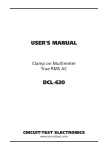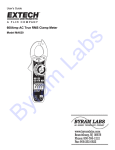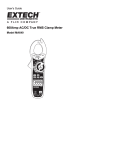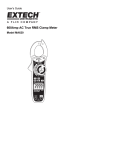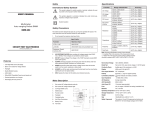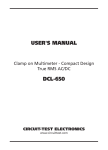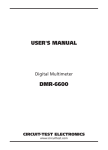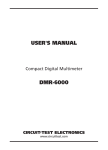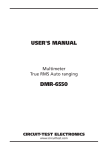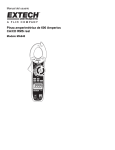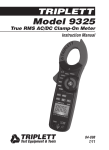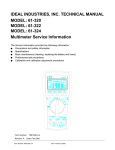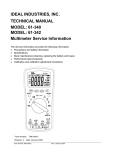Download USER`S MANUAL DCL-680
Transcript
USER'S MANUAL Clamp on Multimeter True RMS AC/DC DCL-680 CIRCUIT-TEST ELECTRONICS www.circuittest.com Safety International Safety Symbols This symbol, adjacent to another symbol or terminal, indicates the user must refer to the manual for further information. This symbol, adjacent to a terminal, indicates that, under normal use, hazardous voltages may be present. Double insulation SAFETY NOTES • Do not exceed the maximum allowable input range of any function. • Do not apply voltage to meter when resistance function is selected. • Set function switch OFF when the meter is not in use. WARNINGS • Set function switch to the appropriate position before measuring. • When measuring volts do not switch to current/resistance modes. • When changing ranges using the selector switch always disconnect the test leads from the circuit under test. • Do not exceed the maximum rated input limits. -2- CAUTIONS Improper use of this meter can cause damage, shock, injury or death. Read and understand this user manual before operating the meter. • Always remove the test leads before replacing the battery. • Inspect the condition of the test leads and the meter itself for any damage before operating the meter. Repair or replace any damage before use. • Use great care when making measurements if the voltages are greater than 25VAC rms or 35VDC. These voltages are considered a shock hazard. • Remove the battery if the meter is to be stored for long periods. • Always discharge capacitors and remove power from the device under test before performing Diode, Resistance or Continuity tests. • Voltage checks on electrical outlets can be difficult and misleading because of the uncertainty of connection to the recessed electrical contacts. Other means should be used to ensure that the terminals are not "live". • If the equipment is used in a manner not specified by the manufacturer, the protection provided by the equipment may be impaired. Input Limits Function Maximum Input A AC/DC 1000A V DC, V AC 600V DC/AC Frequency, Resistance, Diode, 250V DC/AC Continuity, Capacitance Test Temperature (°C/°F) 250V DC/ AC -3- Meter Description 1. Current clamp 2. Non-contact AC voltage indicator light 3. Clamp trigger 4. Data Hold and Backlight button 5. Function switch 6. Hz % button 7. RANGE button 8. Relative button 9. MIN/MAX button 10. MODE button 11. LCD display 12. COM input jack 13. Positive input jack AC DC AUTO REL HOLD MAX MIN °C,°F μ,m, n,M,k A V F Hz % Ω Alternating current Direct currrent Autoranging Relative Diode test Continuity test Data Hold Maximum reading Minimum reading Celsius, Fahrenheit (temperature) Units of measure: micro, milli, nano, mega, kilo Amperes (current) Volts (voltage) Farad (capacitance) Frequency Duty ratio Low Battery Ohms -4- Specifications Function Range & Resolution Accuracy (% of reading) AC Current (50/60Hz) 600.0 AAC ± (2.8 % + 8 digits) AC Current (400Hz) 600.0 AAC ± (5.0 % + 10 digits) DC Current 1000 AAC ± (3.0 % + 8 digits) 1000 AAC ± (5.0 % + 10 digits) 600.0 ADC ± (2.8 % + 5 digits) 1000 ADC 600.0 mVDC DC Voltage 6.000 VDC 6.000 VAC 60.00 VAC ± (1.8% + 8 digits) 600.0 Ω ± (1.0% + 4 digits) 60.00KΩ ± (1.5% + 2 digits) 6.000MΩ ± (2.5% + 3 digits) 40.00nF ± (4.0% + 20 digits) 600.0 VAC 6.000KΩ Resistance 600.0KΩ 60.00MΩ ± (3.5% + 5 digits) 400.0nF Capacitance 4.000μF ± (3% + 5 digits) 400.0μF ± (4.0% + 10 digits) 10-10kHz ± (1.5% + 2 digits) -20.0 to 760.0°C ± (3% + 5°C) 40.00μF 4000μF Frequency Sensitivity:15Vrms Temp (type-K) (probe accuracy not included) ± (0.8% + 2 digits) ± (1.5% + 2 digits) 60.00 VDC 600.0 VDC AC Voltage (50-400Hz) ± (3.0 % + 5 digits) ± (5.0% + 10 digits) -4.0 to 1400.0°F -5- ± (3% + 9°F) Clamp size Diode Test Continuity Check Low Battery Indication Overrange Indication Measurement Rate Input Impedance Display AC Current AC Voltage bandwidth Operating Temperature Storage Temperature Operating Humidity Storage Humidity Operating Altitude Battery Auto OFF Dimensions / Weight Safety / Approvals Opening 1.5" (40mm) approx. Test current of 0.3mA typical; Open circuit voltage 1.5V DC typical. Threshold <40Ω; Test current < 0.5mA “ ” is displayed “OL” is displayed 2 per second, nominal 10MΩ (VDC and VAC) 6000 counts LCD 50-400Hz (AAC) 50-400Hz (VAC) 41 to 104°F (5 to 40°C) -4 to 140°F (-20 to 60°C) Max 80% up to 87°F (31°C) decreasing linearly to 50% at 104°F (40°C) <80% 7000ft. (2000 meters) maximum. One 9V Battery approx. 15 minutes 232x77x39mm / 271g This meter is UL and CUL approved and conforms to IEC61010-1 for Overvoltage Category CAT III 600V -6- Operation NOTES: Read and understand all warning and caution statements in this operation manual before using this meter. Set the function select switch to the OFF position when the meter is not in use. AC/DC Current Measurements WARNING: Ensure that the test leads are disconnected from the meter before making current clamp measurements. 1. Set the Function switch to 1000 , 600 , 1000 , or 600 range. 2. If the range of the measured is not known, select the higher range first then move to the lower range if necessary. 3. Press the trigger to open jaw. Fully enclose one conductor to be measured. The clamp meter LCD will display the reading. DC/AC Voltage Measurements 1. Insert the black test lead into the negative COM terminal and the red test lead into the positive V terminal. 2. Set the function switch to position. 3. Select AC or DC with the MODE button. 4. Connect the test leads in parallel to the circuit under test. 5. Read the voltage measurement on the LCD display. Resistance Measurements 1. Insert the black test lead into the negative COM terminal and the red test lead into the positive terminal. 2. S et the function switch to the Ω position. Touch the test probe tips across the circuit or component under test. It is best to disconnect one side of the device under test so the rest of the circuit will not interfere with the resistance reading. 3. Read the resistance value on the LCD display. -7- Diode and Continuity Measurements 1. Insert the black test lead banana plug into the negative COM jack and the red test lead banana plug into the positive diode jack. 2. Turn the rotary switch to the position. 3. Press the MODE button until “ ” appears in the display. 4. T ouch the test probes to the diode under test. Forward voltage will indicate 0.4V to 0.7V. Reverse voltage will indicate “OL”. Shorted devices will indicate near 0mV and an open device will indicate “OL” in both polarities. 5. Press MODE button to display . 6. For Continuity tests, if resistance is < 40Ω, tone will sound. Capacitance Measurements WARNING: To avoid electric shock, disconnect power to the unit under test and discharge all capacitors before taking any capacitance measurements. Remove the batteries and unplug the line cords. 1. Set the rotary function switch to the position. 2. Insert the black test lead banana plug into the negative COM jack. Insert the red test lead banana plug into the positive V jack. 3. Press MODE until "nF" appears in the display. 4. Touch the test leads to the capacitor to be tested. 5. Read the capacitance value in the display -8- Frequency/Duty Cycle Measurements 1. Set the rotary function switch to Hz position. 2. Select ACV with the MODE button 3. Press the Hz/% button to indicate “Hz” in the display. 4. Insert the black lead banana plug into the negative COM jack 5. Insert the red test lead banana plug into the positive Hz jack. 6. Touch the test probe tips to the circuit under test. 7. Read the frequency on the display. 8. Press the Hz/% button again to indicate “%” on the display. 9. Read the % of duty cycle on the display. Temperature Measurements WARNING: To avoid electric shock, disconnect both test probes from any source of voltage before making a temperature measurement. 1. Set the function switch to °C / °F. 2. Insert the Temperature Probe into the negative COM and the V jacks, making sure to observe the correct polarity. 3. Touch the Temperature Probe head to the part whose temperature you wish to measure. Keep the probe touching the part under test until the reading stabilizes (about 30 seconds). 4. Read the temperature in the display. The digital reading will indicate the proper decimal point and value. WARNING: To avoid electric shock, be sure the thermocouple has been removed before changing to another measurement function -9- Non-Contact AC Voltage Measurements WARNING: Risk of Electrocution. Before use, always test the Voltage Detector on a known live circuit to verify proper operation 1. Touch the probe tip to the hot conductor or insert into the hot side of the electrical outlet. 2. If AC voltage is present, the detector light will illuminate. NOTE: The conductors in electrical cord sets are often twisted. For best results, rub the probe tip along a length of the cord to assure placing the tip in close proximity to the live conductor. NOTE: The detector is designed with high sensitivity. Static electricity or other sources of energy may randomly trip the sensor. This is normal operation MODE Button To select DC/ACV, OHM/Diode/Continuity/CAP, °C / °F MAX & MIN Recording Button Press MAX/MIN to enter MIN, MAX recording mode (manual range only). Select the proper range before selecting this mode to ensure that the MIN/MAX reading will not exceed the testing range. Press once to select MAX. Press again to select MIN and press and hold MAX/MIN button to exit this mode. REL Button For DCA Zero & Offset adjustment. Data Hold Button To freeze the LCD meter reading, press the data hold button. While data hold is active, the HOLD display icon appears on the LCD. Press the data hold button again to return to normal operation. - 10 - RANGE Button When the meter is first turned on, it automatically goes into AutoRanging. This automatically selects the best range for the measurements being made and is generally the best mode for most measurements. For measurement situations requiring that a range be manually selected, perform the following: 1. P ress the RANGE button. The “Auto Range” display indicator will turn off. 2. P ress the RANGE button to step through the available ranges until you select the range you want. 3. Press and hold the RANGE button for 2 seconds to exit the Manual Ranging mode. Backlight Button The backlight function illuminates the display and is used when the ambient light to too low to permit viewing of the displayed readings. Press the button for two seconds to turn the backlight on. The backlight will automatically turn off after approximately 5 seconds. Battery Replacement 1. Remove the two rear Phillips head screw 2. Open the battery compartment 3. Replace the 9V battery observing the correct polarity 4. Re-assemble the meter - 11 - Limited Warranty Circuit-Test Electronics warrants to the original purchaser that this product be free of defect in material or workmanship for a period of 2 years from the date of purchase. Any product which has been subjected to misuse or accidental damage is excluded from the warranty. Except as stated above, Circuit-Test Electronics makes no promises or warranties either expressed or implied including warranties of merchantability or the fitness for any particular purpose. M-DCL-680 / 07R13 - 12 -












